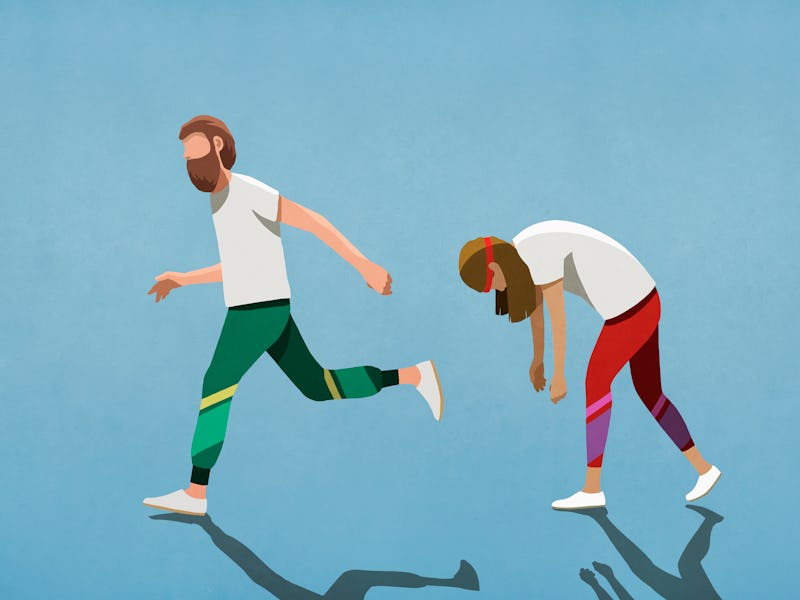Exercise motivators: 4 psychological fixes to get back on track
They type of motivation driving exercise is key to sustaining it in the long-term.

In the early phases of lockdown, the streets were teeming with runners, and living rooms were a blur of uncoordinated star jumps and lunges. In fact, physical activity levels peaked around mid-to-late May, just before lockdown restrictions began to be eased. Now, after months of fluctuating social restrictions, many people are reporting on social media that they’ve suddenly lost their motivation to exercise.
The truth is that motivation is simply returning to normal. The weather was ideal for exercise in April and May, and many of us had more time available to squeeze in a workout. Two major barriers to exercise were removed. Usually, motivation is a battle of different choices. In normal circumstances, exercise fights against many other appealing leisure pursuits, such as going to the pub, the cinema, or spending time with friends. But during the most severe part of the national lockdown, the choice was either to go outside for exercise or stay home all day. The motivational odds shifted in favor of exercise.
Lockdowns around the world also acted in a similar way to a new year, new school term, or birthday. Significant dates and events can disrupt routines and provide a chance to make a fresh start, so many of us began to exercise. But, like new year’s resolutions, our motivation steadily faded over time.
The type of motivation needed to start a new behavior is often very different from the motivation needed to sustain one. Most people start exercising because they know it’s good for them, and outside pressures (such as from TV adverts, or friends) tell them they should. “Should-do” motives are an effective way to start a new behavior.
But as lockdown eased, barriers to exercise appeared again – such as being able to spend time with friends at the pub, or the need to get one's children ready for school again. Relying on “should-do” motives in these scenarios requires considerable mental effort and willpower. Unfortunately, one of the most interesting aspects of human motivation is that we dislike the feeling of effort and willpower and tend to avoid it. The pub, the kids, tiredness, and work all win the battle against exercise. “Should-do” motives are terrible at sustaining exercise behavior.
Even some people who exercised religiously are reporting the loss of motivation. But again, the type of motivation driving their exercise may explain why this has happened. People who exercise to seek approval from others or to boost their self-esteem often report increased anxiety and body dissatisfaction, despite high levels of exercise. Lockdown (and gym closures) may have increased these negative feelings because the situation meant that people weren’t getting the compliments and boost to the ego that they sought.
To stop these motivational declines, a dual approach is needed that makes exercise easy in the short-term while developing strong long-term motivation. When it comes to long-term motivation, many psychologists believe your identity is one of the most resilient motivational systems. Identity can often be a vague term and difficult to describe, but put simply, “be” goals are more motivating than “do” goals. So instead of “doing” exercise, focus on “being” someone who exercises.
These “be” motives require much less mental effort to act on and you will naturally seek opportunities to demonstrate your “exerciser” identity. It’s less mentally exhausting “being” an exerciser, compared to continuously trying to “do” exercise because attention is naturally drawn to opportunities to exercise and away from other temptations. In some ways, this isn’t fair. Those people who have exercised for years and see themselves as an exerciser find it very easy to be motivated to exercise. Those of us who don’t view ourselves as exercisers, but want to exercise, require a lot of mental effort and willpower to leave the house.
Doing activities you like will help motivate you to exercise.
This process takes some time, so we also need quick motivational fixes while our healthy exerciser identity develops. In the short-term, the guiding principle should be to minimize the effort required to exercise:
- Plan your exercise for when it’s easiest to do. For many, this may mean exercising as soon as possible in the day before temptations, and obstacles that require effort to overcome begin to appear.
- Make it easy to exercise. Get your sportswear out of the drawer and ready the evening before. Plan exercise that does not require travel to a specific venue. Do as many things as you can beforehand so that, when the time comes, starting your workout is easy.
- Break the process of exercising into chunks. For example, getting changed into sportswear only require a little effort. Stepping out of the door only requires a little effort. Before you know it, it’s harder to not exercise than to exercise.
- Do what you enjoy. It’s simple and requires minimal motivation to repeat the exercise that felt good. If you find yourself wanting to jump rope or dance instead of lifting weights or jogging, it’s better to do what you want to do and requires a lot less mental effort than trying to force yourself to do something you think you should do.
While many of us aren’t looking forward to furthering social restrictions, this might give us another opportunity to develop a healthier lifestyle. A focus on “being” an exerciser and minimizing mental effort will lead to fewer sudden declines in exercise motivation over the long term.
This article was originally published on The Conversation by Ian Taylor at Loughborough University. Read the original article here.
This article was originally published on